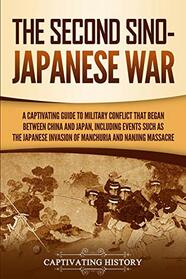This is the combination of two books about the second war between the Chinese and Japanese, plus the horrifying story of the Rape of Nanking. Although the Japanese called the war in the 1930s and 1940s the "Japan-China Incident," an incredible 20 million people died -- mostly Chinese.
One of the strengths of Captivating History selections is that they tell the backstory with enough detail to make the later actions understandable.
THE SECOND SINO-JAPANESE WAR --
The roots of the wars between Japan and China are fascinating reading because there were conflicting factors in the countries that brought about these wars. This book encapsulates the issues succinctly, "Though Japan's operations in China were meant to increase its empire, power, and prestige around the world, there was another factor: resources."(p. 26) Japan was a resource-needy nation, so Japan set its sights on resource-rich Manchuria and a weak China in turmoil.
The death counts, particularly in Wuhan (October 25, 1938), were staggering. Between 600,000 and 1 million Chinese died there and the Japanese lost an estimated 250,000. Those are shocking losses.
However, Dr. Ishii deserves special notice for the horrific experiments and diseases he released deliberately on prisoners. Unnecessary surgeries, tests to gauge survivability of certain awful treatments, and testing to see how long fetuses could survive in impossible situations, were all part of the Japanese testing program. Dr. Ishii and his colleagues planned to infect the US West Coast with plague-infested fleas they had created and used in China. Fortunately, his plan collapsed before its use.
The last chapter of this section was very helpful in closing out the second Sino-Japanese War and setting the stage for the fighting between the Communist and Nationalist Chinese. This also helps to explain why the Korean War happened.
THE RAPE OF NANKING --
One of the fairly untold stories of World War II was the atrocities outlined in this second section. This particular massacre lasted six weeks. Most of the records were destroyed so that historians do not know how many people were killed. The estimates are between 40,000 and 300,000 unarmed people were murdered during this time. The military of Japan was very aggressive towards their weaker neighbor, China.
The author explains the âThree Allsâ Policy (kill all, burn all, loot all) and how the military indoctrinated14-year-olds into the âWarrior Code.â It was all based on the ancient samurai's noble code of conduct. It was of the highest nobility to die for one's emperor. Seppuku (committing suicide to atone for failure or loss) and kamikaze (pilots who killed themselves by taking as many of their enemies with them) were taught.
The Japanese expected an easy victory and when that didn't happen in Shanghai, they were angry. Japanese wanted to show how powerful they were, in spite of universally agreed-to rules of deportment regarding innocent civilians and soldiers who had surrendered. The author makes a point that the murders, rapes, mutilations, etc., were not because of undisciplined soldiers, but a complete disregard for international law by the officers.
As much as 1/3 of Nanking was destroyed by the looting and burning of buildings, businesses, and culture.
One of the strengths of Captivating History selections is that they tell the backstory with enough detail to make the later actions understandable.
THE SECOND SINO-JAPANESE WAR --
The roots of the wars between Japan and China are fascinating reading because there were conflicting factors in the countries that brought about these wars. This book encapsulates the issues succinctly, "Though Japan's operations in China were meant to increase its empire, power, and prestige around the world, there was another factor: resources."(p. 26) Japan was a resource-needy nation, so Japan set its sights on resource-rich Manchuria and a weak China in turmoil.
The death counts, particularly in Wuhan (October 25, 1938), were staggering. Between 600,000 and 1 million Chinese died there and the Japanese lost an estimated 250,000. Those are shocking losses.
However, Dr. Ishii deserves special notice for the horrific experiments and diseases he released deliberately on prisoners. Unnecessary surgeries, tests to gauge survivability of certain awful treatments, and testing to see how long fetuses could survive in impossible situations, were all part of the Japanese testing program. Dr. Ishii and his colleagues planned to infect the US West Coast with plague-infested fleas they had created and used in China. Fortunately, his plan collapsed before its use.
The last chapter of this section was very helpful in closing out the second Sino-Japanese War and setting the stage for the fighting between the Communist and Nationalist Chinese. This also helps to explain why the Korean War happened.
THE RAPE OF NANKING --
One of the fairly untold stories of World War II was the atrocities outlined in this second section. This particular massacre lasted six weeks. Most of the records were destroyed so that historians do not know how many people were killed. The estimates are between 40,000 and 300,000 unarmed people were murdered during this time. The military of Japan was very aggressive towards their weaker neighbor, China.
The author explains the âThree Allsâ Policy (kill all, burn all, loot all) and how the military indoctrinated14-year-olds into the âWarrior Code.â It was all based on the ancient samurai's noble code of conduct. It was of the highest nobility to die for one's emperor. Seppuku (committing suicide to atone for failure or loss) and kamikaze (pilots who killed themselves by taking as many of their enemies with them) were taught.
The Japanese expected an easy victory and when that didn't happen in Shanghai, they were angry. Japanese wanted to show how powerful they were, in spite of universally agreed-to rules of deportment regarding innocent civilians and soldiers who had surrendered. The author makes a point that the murders, rapes, mutilations, etc., were not because of undisciplined soldiers, but a complete disregard for international law by the officers.
As much as 1/3 of Nanking was destroyed by the looting and burning of buildings, businesses, and culture.




